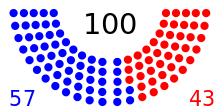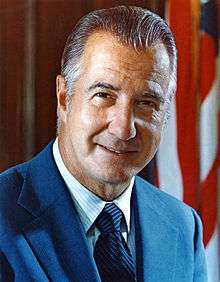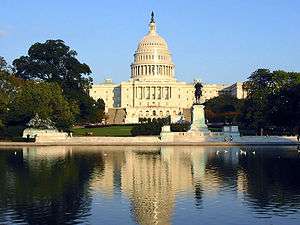91st United States Congress
| 91st United States Congress | |||||||||||||||||||||||||||||
| |||||||||||||||||||||||||||||
The Ninety-first United States Congress was a meeting of the legislative branch of the United States federal government, composed of the United States Senate and the United States House of Representatives. It met in Washington, DC from January 3, 1969 to January 3, 1971, during the first two years of the first administration of U.S. President Richard Nixon.
The apportionment of seats in this House of Representatives was based on the Eighteenth Census of the United States in 1960. Both chambers had a Democratic majority.
Major events
Major legislation

- December 30, 1969: Federal Coal Mine Health and Safety Act, Pub.L. 91–173
- 1969: Tax Reform Act of 1969, Pub.L. 91–172
- January 1, 1970: National Environmental Policy Act, Pub.L. 91–190
- April 3, 1970: Environmental Quality Improvement Act, Pub.L. 91–224
- May 21, 1970: Airport and Airway Development Act, Pub.L. 91–258, title I
- August 12, 1970: Postal Reorganization Act (United States Postal Service), Pub.L. 91–375
- August 15, 1970: Economic Stabilization Act
- September 22, 1970: District of Columbia Delegate Act, Pub.L. 91–405
- October 15, 1970: Organized Crime Control Act, Pub.L. 91–452 (including the Racketeer Influenced and Corrupt Organizations Act ("RICO")
- 1970: Urban Mass Transportation Act of 1970, Pub.L. 91–453
- October 26, 1970: Bank Secrecy Act, Pub.L. 91–508
- October 27, 1970: Controlled Substances Act, Pub.L. 91–513
- 1970: Rail Passenger Service Act (Amtrak), Pub.L. 91–518
- December 24, 1970: Family Planning Services and Population Research Act of 1970, Pub.L. 91–572
- December 24, 1970: Plant Variety Protection Act, Pub.L. 91–577
- December 29, 1970: Occupational Safety and Health Act (OSHA), Pub.L. 91–596
- December 31, 1970: Clean Air Act Extension, Pub.L. 91–604
- December 31, 1970: Housing and Urban Development Act of 1970, Pub.L. 91–609, including title VII, National Urban Policy and New Community Development Act of 1970
- January 12, 1971: Foreign Military Sales Act of 1971, Pub.L. 91–672
- 1971: Lead-Based Paint Poisoning Prevention Act, Pub.L. 91–695
Party summary
The count below identifies party affiliations at the beginning of the first session of this Congress, and includes members from vacancies and newly admitted states, when they were first seated. Changes resulting from subsequent replacements are shown below in the "Changes in membership" section.
Senate

- Democratic: 57 (majority)
- Republican: 43
TOTAL members: 100
House of Representatives
- Democratic: 243 (majority)
- Republican: 192
TOTAL members: 435
Leadership

Senate
- President: Hubert Humphrey (D), until January 20, 1969
- Spiro Agnew (R), from January 20, 1969
- President pro tempore: Richard Russell, Jr. (D)
Majority (Democratic) leadership
Minority (Republican) leadership
- Minority Leader: Everett Dirksen, until September 7, 1969
- Hugh Scott, from September 24, 1969
- Minority Whip: Hugh Scott, until September 24, 1969
- Robert P. Griffin, from September 24, 1969
House of Representatives
- Speaker: John W. McCormack (D)
Majority (Democratic) leadership
Minority (Republican) leadership
Caucuses
Members
This list is arranged by chamber, then by state. Senators are listed in order of seniority, and Representatives are listed by district.
Senate
Senators are popularly elected statewide every two years, with one-third beginning new six-year terms with each Congress. Preceding the names in the list below are Senate class numbers, which indicate the cycle of their election. In this Congress, Class 1 meant their term ended with this Congress, requiring reelection in 1970; Class 2 meant their term began in the last Congress, requiring reelection in 1972; and Class 3 meant their term began in this Congress, requiring reelection in 1974.
House of Representatives

The names of members of the House of Representatives elected statewide on the general ticket or otherwise at-large, are preceded by an "A/L," and the names of those elected from districts, whether plural or single member, are preceded by their district numbers.
Many of the congressional district numbers are linked to articles describing the district itself. Since the boundaries of the districts have changed often and substantially, the linked article may only describe the district as it exists today, and not as it was at the time of this Congress.
Changes in membership
The count below reflects changes from the beginning of the first session of this Congress
Senate
- replacements: 3
- Democratic: 2 seat net gain
- Republican: 2 seat net loss
- deaths: 1
- resignations: 2
- Total seats with changes: 3
| State (class) |
Vacator | Reason for change | Successor | Date of successor's formal installation |
|---|---|---|---|---|
| Illinois (3) |
Everett Dirksen (R) | Died September 7, 1969 | Ralph Tyler Smith (R) | September 17, 1969 |
| Illinois (3) |
Ralph Tyler Smith (R) | Successor elected November 3, 1970 | Adlai Stevenson III (D) | November 17, 1970 |
| Delaware (1) |
John J. Williams (R) | Resigned December 30, 1970 | William V. Roth, Jr. (R) | January 1, 1971 |
| California (1) |
George Murphy (R) | Resigned January 2, 1971 | John V. Tunney (D) | January 2, 1971 |
House of Representatives
- replacements: 14
- Democratic: 2 seat net gain
- Republican: 2 seat net loss
- deaths: 10
- resignations: 8
- Total seats with changes: 18
| District | Vacator | Reason for change | Successor | Date successor seated |
|---|---|---|---|---|
| California 27th | Edwin Reinecke (R) | Resigned January 21, 1969 after becoming Lieutenant Governor of California | Barry Goldwater, Jr. (R) | April 29, 1969 |
| Wisconsin 7th | Melvin R. Laird (R) | Resigned January 21, 1969 after being appointed United States Secretary of Defense | Dave Obey (D) | April 1, 1969 |
| Tennessee 8th | Robert A. Everett (D) | Died January 26, 1969 | Ed Jones (D) | March 25, 1969 |
| Montana 2nd | James F. Battin (R) | Resigned February 27, 1969 after being appointed judge for the US District Court for the District of Montana | John Melcher (D) | June 24, 1969 |
| Illinois 13th | Donald Rumsfeld (R) | Resigned May 25, 1969 after being appointed Director of the Office of Economic Opportunity | Phil Crane (R) | November 25, 1969 |
| Massachusetts 6th | William H. Bates (R) | Died June 22, 1969 | Michael J. Harrington (D) | September 30, 1969 |
| Illinois 6th | Daniel J. Ronan (D) | Died August 13, 1969 | George W. Collins (D) | November 3, 1970 |
| New Jersey 8th | Charles S. Joelson (D) | Resigned September 4, 1969 after becoming judge of Superior Court of New Jersey | Robert A. Roe (D) | November 4, 1969 |
| New Jersey 6th | William T. Cahill (R) | Resigned January 19, 1970 after becoming Governor of New Jersey | Edwin B. Forsythe (R) | November 3, 1970 |
| California 24th | Glenard P. Lipscomb (R) | Died February 1, 1970 | John H. Rousselot (R) | June 30, 1970 |
| California 35th | James B. Utt (R) | Died March 1, 1970 | John G. Schmitz (R) | June 30, 1970 |
| Connecticut 2nd | William St. Onge (D) | Died May 1, 1970 | Robert H. Steele (R) | November 3, 1970 |
| Ohio 19th | Michael J. Kirwan (D) | Died July 27, 1970 | Charles J. Carney (D) | November 3, 1970 |
| Pennsylvania 9th | George Watkins (R) | Died August 7, 1970 | John H. Ware III (R) | November 3, 1970 |
| Illinois 1st | William L. Dawson (D) | Died November 9, 1970 | Vacant | Not filled this term |
| South Carolina 1st | L. Mendel Rivers (D) | Died December 28, 1970 | Vacant | Not filled this term |
| Delaware At-large | William V. Roth, Jr. (R) | Resigned December 31, 1970 after being appointed to the US Senate | Vacant | Not filled this term |
| California 38th | John V. Tunney (D) | Resigned January 2, 1971 after being appointed to the US Senate | Vacant | Not filled this term |
Committees
Lists of committees and their party leaders.
Senate
- Aeronautical and Space Sciences
- Agriculture and Forestry
- Appropriations
- Banking and Currency
- Commerce
- District of Columbia
- Equal Educational Opportunity (Select)
- Finance
- Foreign Relations
- Government Operations
- Interior and Insular Affairs
- Judiciary
- Labor and Public Welfare
- Nutrition and Human Needs (Select)
- Post Office and Civil Service
- Public Works
- Small Business (Select)
- Standards and Conduct (Select)
- Whole
House of Representatives
- Agriculture
- Appropriations
- Banking and Currency
- District of Columbia
- Education and Labor
- Foreign Affairs
- Government Operations
- House Administration
- Interior and Insular Affairs
- Internal Security
- Merchant Marine and Fisheries
- Post Office and Civil Service
- Rules
- Science and Astronautics
- Small Business (Select)
- Standards of Official Conduct
- Transportation and Infrastructure
- Veterans' Affairs
- Ways and Means
- Whole
Joint committees
- Atomic Energy
- Congressional Operations
- Defense Production
- Disposition of Executive Papers
- Economic
- Immigration and Nationality Policy
- Legislative Budget
- The Library
- Navajo-Hopi Indian Administration
- Printing
- Reduction of Nonessential Federal Expenditures
- Taxation
Employees and legislative agency directors
|
Legislative branch agency directors
|
Senate
|
House of Representatives
|
See also
- United States elections, 1968 (elections leading to this Congress)
- United States elections, 1970 (elections during this Congress, leading to the next Congress)
References
- ↑ both representatives were elected statewide on a general ticket
- Martis, Kenneth C. (1989). The Historical Atlas of Political Parties in the United States Congress. New York: Macmillan Publishing Company.
- Martis, Kenneth C. (1982). The Historical Atlas of United States Congressional Districts. New York: Macmillan Publishing Company.
External links
- Biographical Directory of the U.S. Congress
- U.S. House of Representatives: Congressional History
- U.S. Senate: Statistics and Lists
- House of Representatives Session Calendar for the 91st Congress (PDF).
- Congressional Pictorial Directory for the 91st Congress.
- Official Congressional Directory for the 91st Congress, 1st Session.
- Official Congressional Directory for the 91st Congress, 2nd Session.
